
Hover flies, also called flower flies or syrphid flies, make up the insect family Syrphidae. As their common name suggests, they are often seen hovering or nectaring at flowers; the adults of many species feed mainly on nectar and pollen, while the larvae (maggots) eat a wide range of foods. In some species, the larvae are saprotrophs, eating decaying plant and animal matter in the soil or in ponds and streams. In other species, the larvae are insectivores and prey on aphids, thrips, and other plant-sucking insects.
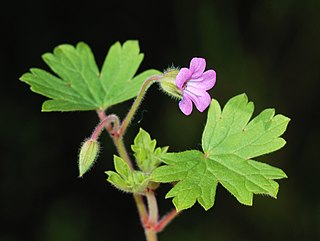
Geraniaceae is a family of flowering plants placed in the order Geraniales. The family name is derived from the genus Geranium. The family includes both the genus Geranium and the garden plants called geraniums, which modern botany classifies as genus Pelargonium, along with other related genera.

The Sphingidae are a family of moths (Lepidoptera) called sphinx moths, also colloquially known as hawk moths, with many of their caterpillars known as “hornworms”; it includes about 1,450 species. It is best represented in the tropics, but species are found in every region. They are moderate to large in size and are distinguished among moths for their agile and sustained flying ability, similar enough to that of hummingbirds as to be reliably mistaken for them. Their narrow wings and streamlined abdomens are adaptations for rapid flight. The family was named by French zoologist Pierre André Latreille in 1802.
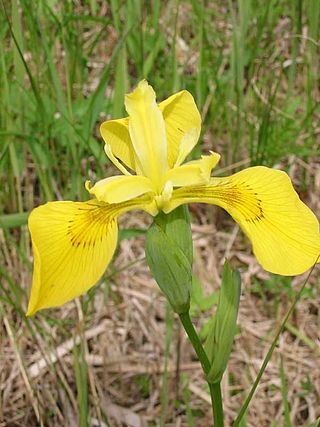
Iridaceae is a family of plants in order Asparagales, taking its name from the irises. It has a nearly global distribution, with 69 accepted genera with a total of c. 2500 species. It includes a number of economically important cultivated plants, such as species of Freesia, Gladiolus, and Crocus, as well as the crop saffron.
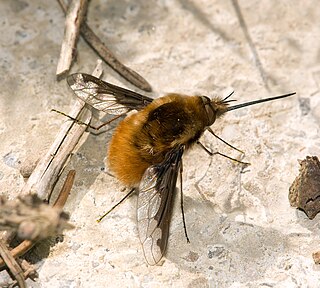
The Bombyliidae are a family of flies, commonly known as bee flies. Adults generally feed on nectar and pollen, some being important pollinators. Larvae are mostly parasitoids of other insects.

Horse-flies and deer flies are true flies in the family Tabanidae in the insect order Diptera. The adults are often large and agile in flight. Only female horseflies bite land vertebrates, including humans, to obtain blood. They prefer to fly in sunlight, avoiding dark and shady areas, and are inactive at night. They are found all over the world except for some islands and the polar regions. Both horse-flies and botflies (Oestridae) are sometimes referred to as gadflies.
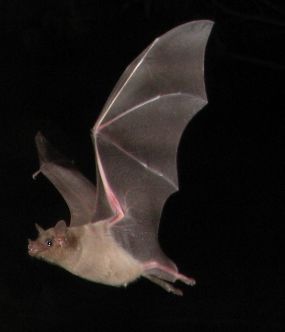
The southern long-nosed bat is a South American species of bat in the family Phyllostomidae.

Angraecum sesquipedale, also known as Darwin's orchid, Christmas orchid, Star of Bethlehem orchid, and king of the angraecums, is an epiphytic orchid in the genus Angraecum endemic to Madagascar. The orchid was first discovered by the French botanist Louis-Marie Aubert du Petit-Thouars in 1798, but was not described until 1822. It is noteworthy for its long spur and its association with the naturalist Charles Darwin, who surmised that the flower was pollinated by a then undiscovered moth with a proboscis whose length was unprecedented at the time. Darwin's prediction went unverified for 21 years after his death, until just such a moth was discovered and his conjecture vindicated. The story of its postulated pollinator has come to be seen as one of the celebrated predictions of the theory of evolution.
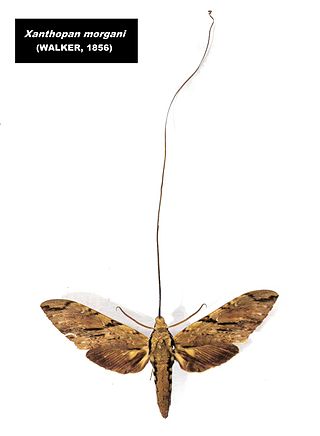
Xanthopan is a monotypic genus of sphinx moth, with Xanthopan morganii, commonly called Morgan's sphinx moth, as its sole species. It is a very large sphinx moth from Southern Africa and Madagascar. Little is known about its biology, though the adults have been found to visit orchids and are one of the main pollinators of several of the Madagascar endemic baobab (Adansonia) species, Adansonia perrieri or Perrier's baobab.

Crocoideae is one of the major subfamilies in the family Iridaceae.

Basiothia schenki, the brown striped hawk, is a moth of the family Sphingidae. The species was first described by Heinrich Benno Möschler in 1872. It is known from Zimbabwe and South Africa.

Roscoea purpurea is a perennial herbaceous plant occurring in the Himalayas, particularly Nepal. Most members of the ginger family (Zingiberaceae), to which it belongs, are tropical, but species of Roscoea grow in much colder mountainous regions. It is sometimes grown as an ornamental plant in gardens.

Philoliche longirostris is a fly of the Tabanidae family that is found in India, Nepal specifically the Himalayas. It was first described and given a binomial name by Thomas Hardwicke in 1823.

Lapeirousia is a genus in the plant family Iridaceae. It is endemic to sub-Saharan Africa, about a third of the species occurring in fynbos.

Stapelia hirsuta, common name starfish flower or carrion plant, is a species of flowering plant belonging to the family Apocynaceae.
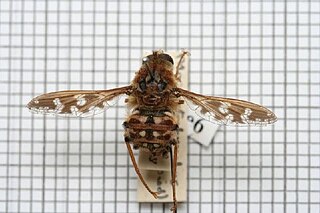
Moegistorhynchus is a genus of tangle-veined flies in the family Nemestrinidae. It was described in 1840 by Pierre-Justin-Marie Macquart.

Lapeirousia pyramidalis is a species of geophyte in the genus Lapeirousia. It is endemic to the Cape Provinces of South Africa. It is also known as the Pyramid Kabong.

Babiana tubiflora is a species of geophyte of 7–15 cm (2.8–5.9 in) high that is assigned to the family Iridaceae. It has whitish mirror-symmetrical flowers with a long narrow tube that split into six tepal lobes, have three stamens, and line- to lance-shaped, laterally compressed leaves. It is an endemic species of South Africa that can be found along the west and south coast of the Western Cape province. It flowers from August to early October.

Babiana brachystachys is a species of geophyte of 20–30 cm (7.9–11.8 in) high that is assigned to the family Iridaceae. It has cream or pale pink, only slightly mirror-symmetrical flowers that are pink on the reverse with a long narrow tube that splits into six tepal lobes, three stamens, a style that divides in three branches opposite the tip of the anthers and line-shaped leaves that are circular in cross section. It is an endemic species of South Africa that can be found on sandy hills and inland dunes in the Northern Cape province. It flowers in September and October.

Lapeirousia anceps, also known as Long Kabong is a species of geophyte in the genus Lapeirousia. It is native in the Cape provinces in South Africa.





















